69 results
Chemistry assessments for Easel Assessments
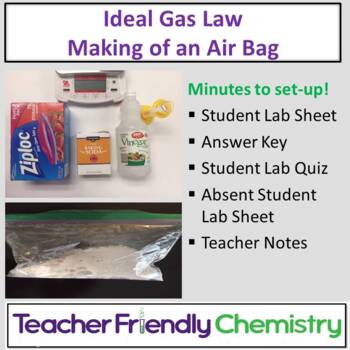
Chemistry Lab: Making of an Air Bag Ideal Gas Law Stoichiometry
Students love this competition between lab groups to make the best air bag! The competition begins by challenging students to exactly fill a Zip-Loc bag. PDF /Word This lab takes minutes to set up! Truly "Teacher Friendly"2- Versions for scaffolding!Students:• Balanced an equation• Use stoichiometry to determine reactant amounts• Use ideal gas law to determine moles of gas neededLab Contains:• Student Lab Sheet• Student Lab Make-up Sheet for Absent Students• Student Lab Sheet with Answers in I
Subjects:
Grades:
9th - 12th
Types:
Also included in: Chemistry Lab Bundle 2: 34 Labs, 27 Inquiry, Quiz, Key, PPT, PDF/Word
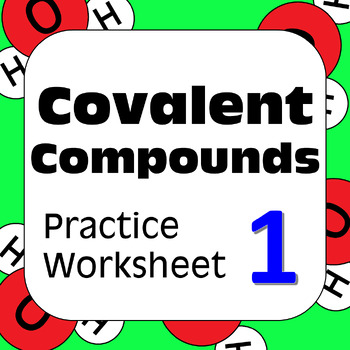
Chemical Nomenclature: Covalent Molecular Compounds Practice Worksheet #1
Practice worksheet containing 40 different covalently bonded compounds. Seventeen questions require the chemical formula, twenty-three questions require the chemical name; different question types are mixed.All compounds are binary; composed of two different nonmetal elements (metalloids included). No ternary/polyatomic ions.Includes multivalent elements.IUPAC-recommended spelling is used.All answers included.This resource includes:1 worksheet (print).1 Easel fillable worksheet (digital).4 Easel
Subjects:
Grades:
7th - 12th, Higher Education, Adult Education
Types:
NGSS:
HS-PS1-1
, HS-PS1-2

Acids, Bases and Salts Learning Package (Distance Learning)
This zip file contains many different activities (58 pages of student handouts and a PowerPoint with a total of 38 slides) which can be used to compose a unit for Chemistry students on topics involving acids and bases. Topics included in this unit are properties of acids and bases, Arrhenius and Bronsted acid-base theory, conjugate acid-base pairs, neutralization/hydrolysis, molarity, pH scale, titrations, as well as other related topics. While these lessons were originally designed to correla
Subjects:
Grades:
9th - 12th
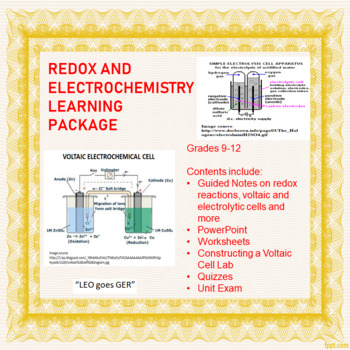
Redox and Electrochemistry Learning Activities (Distance Learning)
This zip file contains many different activities (68 pages of student handouts and 1 PowerPoint with a total of 55 slides) which can be used to compose a unit for chemistry students involving topics in Redox and Electrochemistry. Topics in this unit include determination of oxidation numbers, differences between oxidation and reduction, oxidizing and reducing agents, writing half reactions and net ionic equations, balancing redox reactions, using a replacement series to determine whether a rea
Subjects:
Grades:
9th - 12th
CCSS:
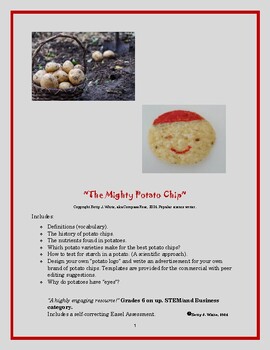
The Mighty Potato Chip: Create a Commercial
~The Mighty Potato Chip: Create a Commercial~Copyright Betty J. White, aka Compass Rose, 2024. Popular science writer.Includes:* Definitions (vocabulary).*The history of potato chips.* The nutrients found in potatoes. (Know your product!)* Which potato varieties make for the best potato chips?* How to test for starch in a potato. (A scientific approach).* Design your own “potato logo” and write an advertisement for your own brand of potato chips. Templates are provided for the commercial with pe
Subjects:
Grades:
6th - 9th
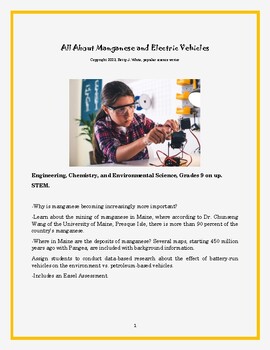
Manganese and Electric Vehicles
Engineering, Chemistry, and Environmental Science, Grades 9 on up.STEM. -Why is manganese becoming increasingly more important? -Learn about the mining of manganese in Maine, where according to Dr. Chunseng Wang of the University of Maine, Presque Isle, there is more than 90 percent of the country’s manganese.-Where in Maine are the deposits of manganese? Several maps, starting 450 million years ago with Pangea, are included with background information.Assign students to conduct data-based resea
Subjects:
Grades:
9th - 12th
Types:
NGSS:
HS-ESS3-4

Bonding Unit Learning Package (Distance Learning)
This zip file contains many different activities (76 pages of student handouts and 1 PowerPoint with a total of 47 slides) which can be used to compose a unit for chemistry students involving topics in bonding. Topics in this unit include properties of electronegativity and its relationship to bond type, covalent bonds (polar and nonpolar), molecular shape and symmetry, ionic bonding, Lewis dot structures, hydrogen bonding, relationship of bonding forces to melting and boiling points and more.
Subjects:
Grades:
9th - 12th
CCSS:
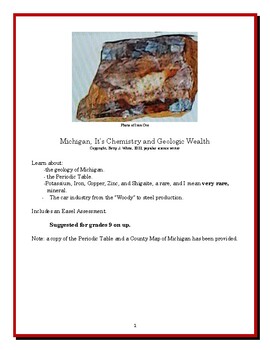
Michigan: Its Chemistry and Geologic Wealth
"Michigan, It’s Chemistry and Geologic Wealth"Copyright, Betty J. White, 2023, popular science writer Learn about: -the geology of Michigan. - the Periodic Table. -Potassium, Iron, Copper, Zinc, and Shigaite, a rare, and I mean very rare, mineral.- The car industry from the “Woody” to steel production. - Assign research on how fertilizer run-off affects the water systems in Michigan.Includes an Easel Assessment. Suggested for grades 9 on up. Note: a copy of the Periodic Table and a County Map
Subjects:
Grades:
9th - 12th
Types:
NGSS:
HS-ESS3-1
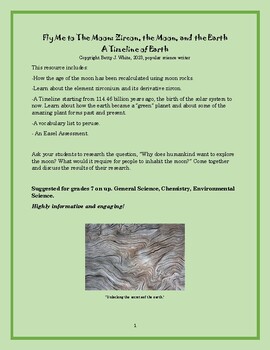
Zircon, the Moon, and Earth: A Timeline of the Earth
"Fly Me to The Moon: Zircon, the Moon, and the Earth: A Timeline of Earth" Copyright Betty J. White, 2023, popular science writer This resource includes:-How the age of the moon has been recalculated using moon rocks.-Learn about the element zirconium and its derivative zircon.-A Timeline starting from 114.46 billion years ago, the birth of the solar system to now. Learn about how the earth became a “green” planet and about some of the amazing plant forms past and present.-A
Subjects:
Grades:
9th - 12th
Types:
NGSS:
MS-ESS3-1
, MS-ESS3-5
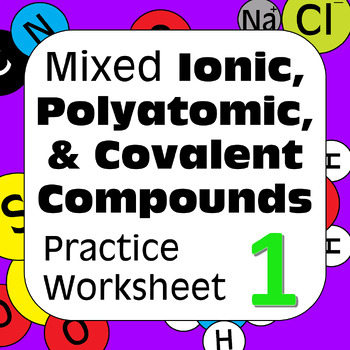
Chemical Nomenclature: Mixed Ionic Polyatomic & Covalent Compounds Practice #1
Practice worksheet containing 40 different compounds: ten binary ionic (monovalent); ten binary ionic (multivalent); ten ternary/polyatomic, and ten covalent. The first of two mixed compounds practice worksheets. Twenty-one questions require the chemical formula, nineteen questions require the chemical name; different question types are mixed.IUPAC-recommended spelling is used.All answers included. This resource includes:1 worksheet (print).1 Easel fillable worksheet (digital).4 Easel multiple-
Subjects:
Grades:
7th - 12th, Higher Education, Adult Education
Types:
NGSS:
HS-PS1-1
, HS-PS1-2

Significant Figures Quiz
A FREE quick quiz to check for understanding in identifying sig figs and correctly rounding them in calculations.Answer Key Included
Subjects:
Grades:
9th - 12th
Types:
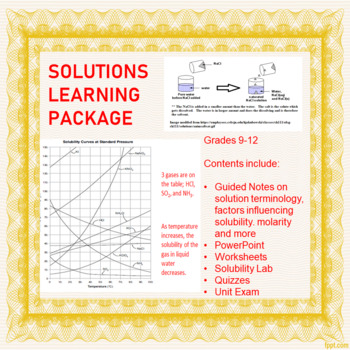
Solutions Learning Package (Distance Learning)
This zip file contains many different activities (54 pages of student handouts and 1 PowerPoint with a total of 63 slides) which can be used to compose a unit for chemistry students involving Solutions. Topics in this unit include solutions, colloids and suspensions, saturated, unsaturated and supersaturated solutions, solubility curves, discussion of some factors influencing solubility, percent of solution, molarity including calculations, parts per million calculations and colligative propert
Subjects:
Grades:
9th - 12th
CCSS:
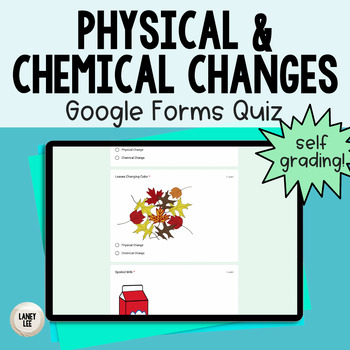
Physical & Chemical Changes Google Forms Quiz
Save time with this Physical & Chemical Google Form quiz! Need a quick way to provide feedback? Use this self grading Google form! The questions in this 16 question assessment are designed to be rigorous and require students to predict, reflect, connect, and think critically about the content being presented.Topics Covered in this Assessment:identifying physical changesidentifying chemical changes Who is this resource for?This resource can be used by classroom teachers, tutors, and parents o
Subjects:
Grades:
7th - 10th
Types:
Also included in: Middle School Physical Science Curriculum

Chemical Nomenclature: Compounds with Polyatomic Ions Practice Worksheet #1
Practice worksheet containing 28 different ternary/polyatomic compounds; the first of two polyatomic compound worksheets. Twelve questions require the chemical formula, sixteen questions require the chemical name.A short list of polyatomic ions and names is included at the top of the page for easy reference.All compounds contain at least one ternary/polyatomic ion. All compounds, therefore, are composed of three or more different elements. Includes multivalent elements.IUPAC-recommended spelling
Subjects:
Grades:
8th - 12th, Higher Education, Adult Education
Types:
NGSS:
HS-PS1-1
, HS-PS1-2
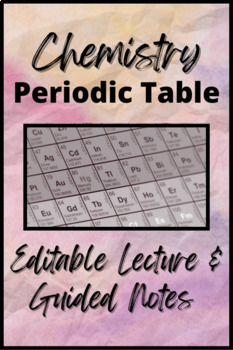
Chemistry: Unit 6 Periodic Table & Trends PowerPoint and Lecture Guide
This resource includes an 6 page lecture guide, 10 question Easel Assessment and a simple 63 slide PowerPoint for Atomic Theory. The topics are in accordance with Florida's Next Generation Sunshine State Standards for Science. Answers and explanations are included on either the slide or in the notes section of the PowerPoint. Bonus: there are two questions from the lecture included in a 2 slide Easel Activity based on the families of the periodic table and two review multiple choice questions.Pl
Subjects:
Grades:
8th - 11th
NGSS:
HS-PS1-1
, HS-PS1-2
Also included in: Chemistry Full Year (Units 1-17) PowerPoints and Lecture Guides Bundle
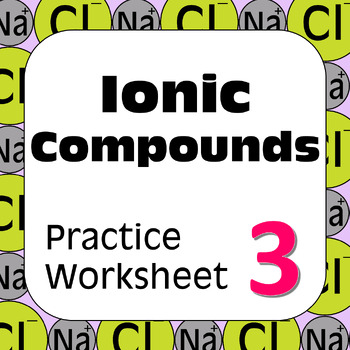
Chemical Nomenclature: Ionic Compounds Practice Worksheet #3
Practice worksheet containing 40 different ionic compounds; the third of three scaffolded ionic compound practice worksheets.Twenty questions require the chemical formula, and twenty questions require the chemical name.One print plus two different digital formats provide all the flexibility needed in one handy resource.All compounds are binary; composed of two different elements, one metal and one nonmetal.Includes multivalent elements.IUPAC-recommended spelling is used.All answers included.This
Subjects:
Grades:
7th - 12th, Higher Education, Adult Education
Types:
NGSS:
HS-PS1-1
, HS-PS1-2
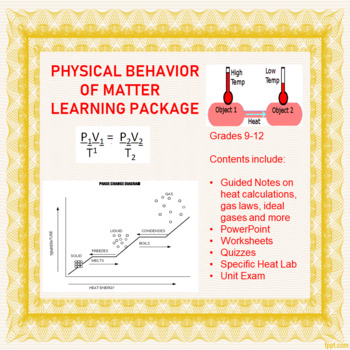
Physical Behavior of Matter Learning Package (Distance Learning)
This zip file contains many different activities (43 pages of student handouts and 1 PowerPoint with a total of 59 slides) which can be used to compose a unit for chemistry students involving the Physical Behavior of Matter. Topics in this unit include temperature conversions, phases of matter, changes of state, specific heat, heat of fusion, heat of vaporization and computations involving these topics. Additional topics include the Gas Laws and computations involving these (Boyle's Law, Charl
Subjects:
Grades:
9th - 12th
CCSS:
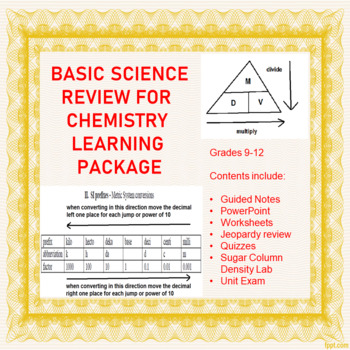
Basic Science Skills Chemistry Learning Package (Distance Learning)
This zip file contains many different activities (55 pages of student handouts and PowerPoints with a total of 116 slides) which can be used to compose a unit for chemistry students introducing and reviewing some basic science skills required for chemistry. While these lessons were originally designed to correlate to the performance indicators of the New York State Chemistry - Physical Setting curriculum, the components of this lesson may be easily used in other chemistry or physical science cou
Subjects:
Grades:
9th - 12th
CCSS:
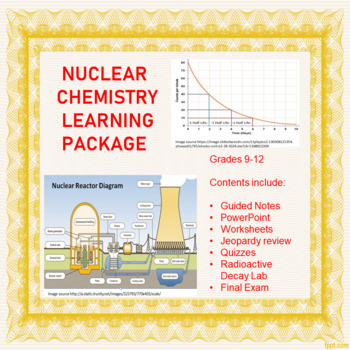
Nuclear Chemistry Learning Package (Distance Learning)
This zip file contains many different activities (44 pages of student handouts and 2 PowerPoints with a total of 93 slides) which can be used to compose a unit for chemistry students involving the basics on Nuclear Chemistry. Topics in this unit include fission, fusion, transmutation, types of radioactive decay, properties of alpha particles, beta particles and gamma rays, balancing nuclear equations, uses of some common radioisotopes, nuclear reactors and problems with the disposal of nuclear
Subjects:
Grades:
9th - 12th
CCSS:
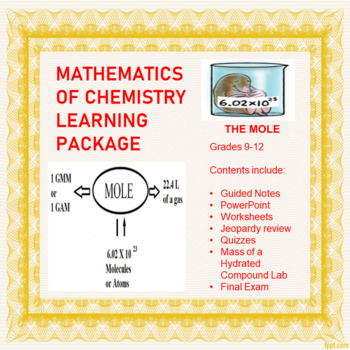
The Mathematics of Chemistry Learning Package (Distance Learning)
This zip file contains many different activities (43 pages of student handouts and a PowerPoint with a total of 43 slides) which can be used to compose a unit for Chemistry students on topics involving the Mathematics of Chemistry. Topics included in this unit are calculation of gram molecular mass, percent composition, water of hydration, the concept of the mole, mole conversions to gram molecular mass and numbers of molecules, mole relationships in equations and determination of empirical and
Subjects:
Grades:
9th - 12th, Higher Education
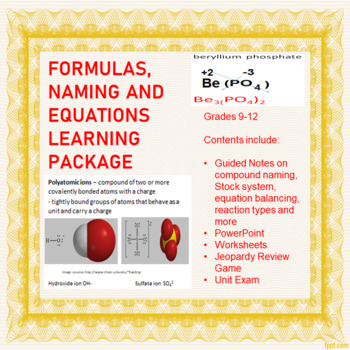
Formulas, Naming and Chemical Equations Learning Package
This zip file contains many different activities (36 pages of student handouts and 2 PowerPoints with a total of 100 slides) which can be used to compose a unit for chemistry students involving the basics on Naming of Chemical Compounds and Types of Chemical Reactions. Topics in this unit include Hydrates, naming binary ionic and covalent compounds, naming ternary compounds, as well as writing the formulas for these compounds when given the name. The balancing of chemical equations (non-redox)
Subjects:
Grades:
9th - 12th
CCSS:
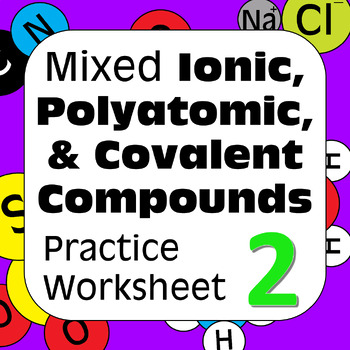
Chemical Nomenclature: Mixed Ionic Polyatomic & Covalent Compounds Practice #2
Practice worksheet containing 40 different compounds: five binary ionic (monovalent); twelve binary ionic (multivalent); twelve ternary/polyatomic, and eleven covalent. The second of two mixed compounds practice worksheets. Eighteen questions require the chemical formula, twenty-two questions require the chemical name; different question types are mixed.IUPAC-recommended spelling is used.All answers included. This resource includes:1 worksheet (print).1 Easel fillable worksheet (digital).4 Ease
Subjects:
Grades:
7th - 12th, Higher Education, Adult Education
Types:
NGSS:
HS-PS1-1
, HS-PS1-2
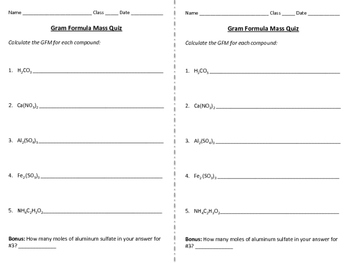
Gram Formula Mass Quiz: Chemistry
Five question quiz plus bonus question about moles and gram formula mass. Two quizzes per page.
Subjects:
Grades:
8th - 12th
Types:
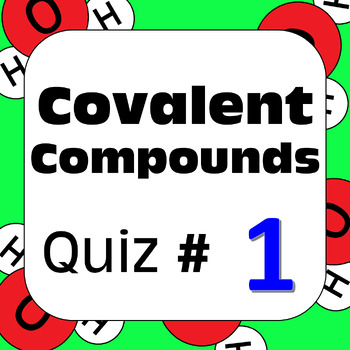
Chemical Nomenclature: Covalent Molecular Compounds Quiz #1
Assessment quiz containing 10 different covalent compounds; the first of seven covalent compound quizzes for chemical nomenclature. Five questions identify the chemical name and require the chemical formula.Five questions identify the chemical formula and require the chemical name.All compounds are binary; composed of two different nonmetal elements (metalloids included). No ternary/polyatomic ions.IUPAC-recommended spelling is used.All answers included.This resource includes:1 worksheet (print)
Subjects:
Grades:
7th - 12th, Higher Education, Adult Education
Types:
NGSS:
HS-PS1-1
, HS-PS1-2
Showing 1-24 of 69 results





